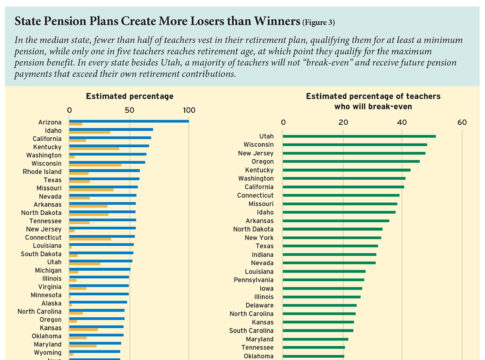Forty-five States Increased Academic Proficiency Standards between 2011 and 2015
Commitments to Common Core generate record gains in state standards, no states receive failing grade
January 22, 2016—The Common Core State Standards (CCSS), adopted by 43 states and the District of Columbia in an effort to establish a set of common educational objectives and standards for assessing student proficiency in reading and math, are accomplishing one of their key goals. That is the finding of a research team writing the latest in a series of studies of state standards for Education Next.
In their study, Harvard University Professor Paul E. Peterson and co-authors Samuel Barrows and Thomas Gift found that 36 states strengthened their proficiency standards between 2013 and 2015, while just five states weakened them. A total of 45 states have raised their standards since 2011. Since most states showing strong improvements have adopted CCSS or similar college- and career-readiness standards, the authors conclude that Common Core very likely induced this dramatic improvement in the rigor of states’ standards.
“It is a hopeful sign that proficiency standards have moved in the right direction,” says Peterson. “If student performance shifts upward in tandem with the rise in expectations, it will signal a long-awaited enhancement in the quality of American schools.”
Peterson, Barrows, and Gift used data from state tests and the National Assessment of Educational Progress (NAEP) to estimate changes to each state’s proficiency standards in reading and math in grades 4 and 8 by identifying the difference between the percentages of students the state identifies as proficient and the percentages of students identified as proficient by NAEP, an internationally-benchmarked proficiency standard. The study’s grading system is designed to assess “the degree to which states are accurately informing parents how well their students are doing on an internationally accepted scale,” or what the authors refer to as “truth in advertising.”
The authors’ findings for 2013-2015 include:
• The average difference between the proportion of students achieving proficiency on NAEP and state tests decreased from 30 percentage points to 10 percentage points nationwide, which the authors describe as “a dramatic improvement over the previous two-year period (2011-13), in which the difference dropped only from 35 to 30 percent.”
• Twenty-four states receive a grade of “A,” indicating that they have set a proficiency bar that is roughly comparable to that set by NAEP: Alaska, Arizona, Arkansas, Colorado, Connecticut, District of Columbia, Georgia, Idaho, Illinois, Kansas, Maine, Maryland, Mississippi, Montana, New Hampshire, New Jersey, New Mexico, New York, North Dakota, Pennsylvania, Rhode Island, South Dakota, Utah, and Vermont. In 2013, nine states earned an “A,” but only New York, Pennsylvania and Utah remained in this elite group in 2015.
• Four states slipped in their proficiency standards ranking: Iowa, Kentucky, North Carolina and Virginia. Massachusetts received a ranking of B plus, lower than its previous A ranking, but this ranking is not definitive, as it is based on information from only one of the two tests that districts were allowed to administer.
• Eighteen states improved their standards by two letter grades or more since 2013: Alabama, Alaska, Arizona, Arkansas, Connecticut, District of Columbia, Georgia, Idaho, Kansas, Louisiana, Maine, Maryland, Mississippi, Montana, New Hampshire, North Dakota, Rhode Island, and South Dakota.
• Iowa, Nebraska, Oklahoma, Virginia, and Texas earned the lowest grades for the rigor of their proficiency standards. Texas was the only state to receive a D.
• Of the seven states not implementing CCSS for both reading and math, six have continued to set low proficiency standards: Indiana, C+; South Carolina, C+; Nebraska, C-; Oklahoma, C-; Virginia, C-; and Texas, D+ (Alaska, A, is the exception).
• The rise in standards between 2013 and 2015 was not concentrated in states receiving Race to the Top (RttT) grants.
• Two states had yet to report test scores for 2015 at the time of the preparation of the data for this article: Florida and Wisconsin.
Despite the significant progress in raising proficiency standards across states, the authors clarify that “high proficiency standards do not necessarily reflect high student performance. It only means that students must perform at a higher level to be identified as proficient in a subject at their grade level.”
Education Next has been tracking state proficiency standards since 2006. The study is the seventh in a series of articles ranking the rigor of states’ proficiency standards. For earlier findings see EdFacts at https://www.educationnext.org/edfacts/.
For an embargoed copy of “After Common Core, States Set Rigorous Standards: Forty-five states raise the student proficiency bar” by Paul E. Peterson, Samuel Barrows, and Thomas Gift, please contact Jackie Kerstetter at jackie@alessicommunication.com. The article will be available Wednesday, January 27, 2016 on https://www.educationnext.org and will appear in the Summer 2016 issue of Education Next.
About the Authors
Paul E. Peterson, editor-in-chief of Education Next, is professor of government and director of the Program on Education Policy and Governance at the Harvard Kennedy School, where Samuel Barrows and Thomas Gift are post-doctoral fellows.
About Education Next
Education Next is a scholarly journal published by the Hoover Institution that is committed to careful examination of evidence relating to school reform. Other sponsoring institutions are the Program on Education Policy and Governance at Harvard University, part of the Taubman Center for State and Local Government at the Harvard Kennedy School, and the Thomas B. Fordham Foundation. For more information, please visit www.educationnext.org.



